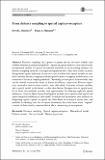Files in this item
From distance sampling to spatial capture-recapture
Item metadata
| dc.contributor.author | Borchers, David L. | |
| dc.contributor.author | Marques, Tiago A. | |
| dc.date.accessioned | 2017-01-16T17:30:08Z | |
| dc.date.available | 2017-01-16T17:30:08Z | |
| dc.date.issued | 2017-10 | |
| dc.identifier | 248517046 | |
| dc.identifier | 75a12666-0ab2-404b-be07-d10f37a976ac | |
| dc.identifier | 85009198588 | |
| dc.identifier | 000412949200007 | |
| dc.identifier.citation | Borchers , D L & Marques , T A 2017 , ' From distance sampling to spatial capture-recapture ' , AStA Advances in Statistical Analysis , vol. 101 , no. 4 , pp. 475-494 . https://doi.org/10.1007/s10182-016-0287-7 | en |
| dc.identifier.issn | 1863-8171 | |
| dc.identifier.other | ORCID: /0000-0002-2581-1972/work/56861279 | |
| dc.identifier.other | ORCID: /0000-0002-3944-0754/work/72842460 | |
| dc.identifier.uri | https://hdl.handle.net/10023/10116 | |
| dc.description | TAM thanks support by CEAUL (funded by FCT—Fundação para a Ciência e a Tecnologia, Portugal, through the Project UID/MAT/00006/2013). | en |
| dc.description.abstract | Distance sampling and capture–recapture are the two most widely used wildlife abundance estimation methods. capture–recapture methods have only recently incorporated models for spatial distribution and there is an increasing tendency for distance sampling methods to incorporated spatial models rather than to rely on partly design-based spatial inference. In this overview we show how spatial models are central to modern distance sampling and that spatial capture–recapture models arise as an extension of distance sampling methods. Depending on the type of data recorded, they can be viewed as particular kinds of hierarchical binary regression, Poisson regression, survival or time-to-event models, with individuals’ locations as latent variables and a spatial model as the latent variable distribution. Incorporation of spatial models in these two methods provides new opportunities for drawing explicitly spatial inferences. Areas of likely future development include more sophisticated spatial and spatio-temporal modelling of individuals’ locations and movements, new methods for integrating spatial capture–recapture and other kinds of ecological survey data, and methods for dealing with the recapture uncertainty that often arise when “capture” consists of detection by a remote device like a camera trap or microphone. | |
| dc.format.extent | 20 | |
| dc.format.extent | 383820 | |
| dc.language.iso | eng | |
| dc.relation.ispartof | AStA Advances in Statistical Analysis | en |
| dc.subject | Distance sampling | en |
| dc.subject | Spatial capture-recapture | en |
| dc.subject | Hierarchical model | en |
| dc.subject | Poisson process | en |
| dc.subject | Survival model | en |
| dc.subject | Binary regression | en |
| dc.subject | HA Statistics | en |
| dc.subject | QA Mathematics | en |
| dc.subject | T-NDAS | en |
| dc.subject | BDC | en |
| dc.subject.lcc | HA | en |
| dc.subject.lcc | QA | en |
| dc.title | From distance sampling to spatial capture-recapture | en |
| dc.type | Journal article | en |
| dc.contributor.institution | University of St Andrews. School of Mathematics and Statistics | en |
| dc.contributor.institution | University of St Andrews. Marine Alliance for Science & Technology Scotland | en |
| dc.contributor.institution | University of St Andrews. Scottish Oceans Institute | en |
| dc.contributor.institution | University of St Andrews. Centre for Research into Ecological & Environmental Modelling | en |
| dc.identifier.doi | 10.1007/s10182-016-0287-7 | |
| dc.description.status | Peer reviewed | en |
This item appears in the following Collection(s)
Items in the St Andrews Research Repository are protected by copyright, with all rights reserved, unless otherwise indicated.

